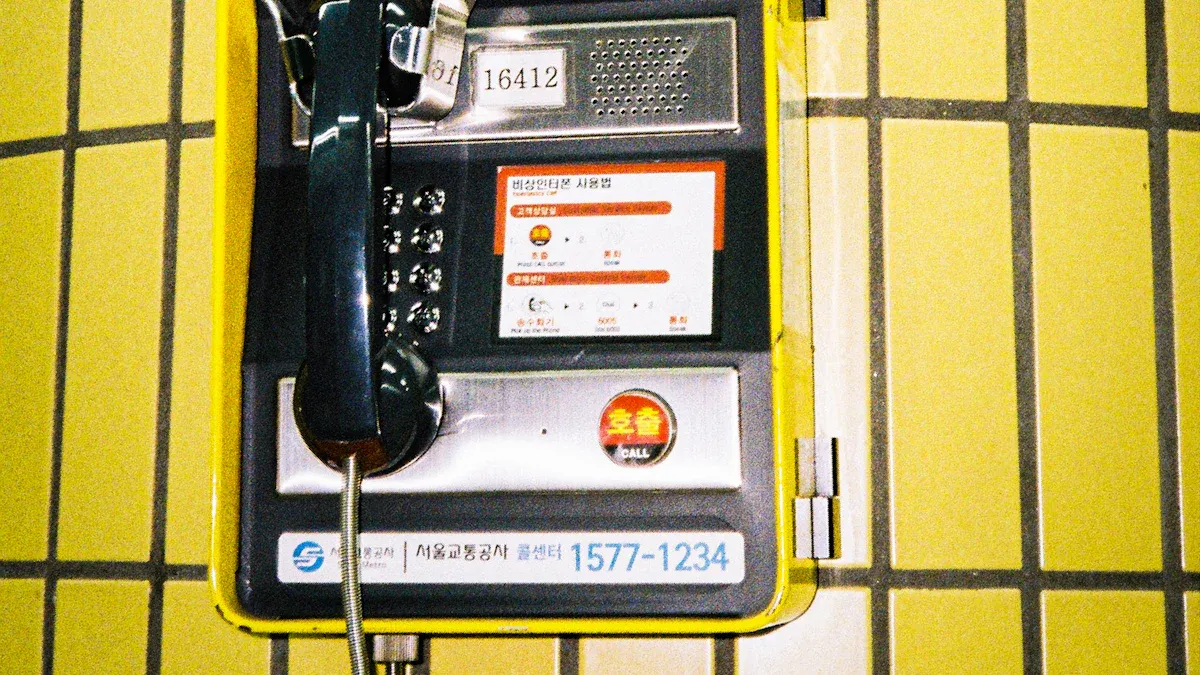
Emergency Explosion Proof Telephones are specialized communication devices engineered for hazardous environments, providing safe and dependable communication in areas with explosive gases, dust, or vapors. These rugged emergency telephones are built to endure extreme conditions, allowing workers to send vital alerts during critical situations. With ATEX Explosion Proof Telephone certifications, these devices meet rigorous safety standards, ensuring reliable performance. In mining operations, Mining Explosion Proof Telephones act as essential lifelines, linking personnel in remote areas to central control systems.
Key Features of Emergency Explosion Proof Telephones

Durability and Rugged Design
Emergency Explosion Proof Telephones are built to endure the harshest conditions in hazardous environments. Their heavy-duty construction, often made from reinforced metals, ensures they can withstand physical impacts, such as accidental drops or collisions. These devices feature shock-resistant designs that protect internal components from damage, maintaining functionality even in challenging situations. The rugged exterior also shields the phone from wear and tear caused by prolonged exposure to industrial settings, making them a reliable choice for long-term use.
Tip: Choosing a telephone with a robust design minimizes the risk of equipment failure during emergencies, ensuring uninterrupted communication when it matters most.
Safety Certifications (ATEX, IECEx)
Safety certifications like ATEX and IECEx validate the reliability of explosion-proof telephones in hazardous areas. These certifications confirm that the devices meet stringent international standards for use in explosive-prone environments. Certified telephones undergo rigorous testing to ensure they do not ignite flammable gases, vapors, or dust. This compliance is critical for industries such as oil and gas, mining, and chemical manufacturing, where safety is paramount.
| Certification | Purpose | Industry Application |
|---|---|---|
| ATEX | Ensures safety in explosive atmospheres | Oil & Gas, Mining |
| IECEx | Verifies compliance with international standards | Chemical Plants, Manufacturing |
Resistance to Extreme Conditions
Explosion-proof telephones are designed to operate reliably in extreme temperatures and adverse environmental conditions. Their water-resistant and shock-resistant features allow them to function even during explosions or severe weather events. The protective casing shields the device from dust, moisture, and corrosive substances, ensuring durability in environments like offshore platforms or underground mines.
- Water and shock resistance enhance performance during emergencies.
- Heavy metal construction prevents damage from accidental drops.
- Protective layers guard against weather-related wear and tear.
These features make emergency Explosion Proof Telephones indispensable for industries requiring robust communication tools in unpredictable settings.
Reliable Communication in Emergencies
Reliable communication is the cornerstone of safety in hazardous environments. Explosion-proof telephones are equipped with advanced technologies, such as VoIP and digital communication systems, to ensure clear and uninterrupted transmission of information. Long-lasting batteries provide extended operational hours, allowing workers to stay connected during prolonged emergencies.
The growing demand for these devices highlights their importance. The market for explosion-proof telephones is projected to grow significantly, driven by industries prioritizing safety and operational efficiency. Stringent workplace regulations further emphasize the need for dependable communication solutions in explosive-prone areas.
Note: Investing in reliable communication systems not only enhances safety but also improves compliance with industry standards.
Hazardous Area Classifications
Zone 0, Zone 1, and Zone 2 Explained
Hazardous areas are classified based on the likelihood and duration of explosive atmospheres. Zone 0 represents environments where explosive gases or vapors are continuously present or exist for long periods. Zone 1 covers areas where such atmospheres are likely to occur during normal operations. Zone 2 includes spaces where explosive atmospheres are infrequent and persist for short durations.
Each zone demands specific safety measures and equipment. Emergency Explosion Proof Telephones designed for Zone 0 must meet the highest safety standards due to constant exposure to explosive conditions. Devices for Zone 1 and Zone 2 require robust construction and certifications to ensure safe operation during potential incidents.
Dust Zones (Zone 20, Zone 21, Zone 22)
Dust zones follow a similar classification system. Zone 20 refers to areas with continuous or prolonged exposure to combustible dust. Zone 21 includes environments where dust clouds are likely during regular operations. Zone 22 applies to spaces where dust clouds occur occasionally and for brief periods.
Explosion-proof telephones used in dust zones must resist dust ingress and prevent ignition risks. Protective casings and advanced sealing technologies ensure safe communication in these environments.
Impact of Classifications on Device Selection
Understanding hazardous area classifications is crucial for selecting the right equipment. Devices must align with the specific zone requirements to ensure safety and compliance. For Zone 0 and Zone 20, manufacturers prioritize advanced safety features and certifications. In less critical zones, durability and environmental resistance remain key factors.
Tip: Always verify the device’s certifications and compatibility with the intended zone before installation.
Industry Applications

Oil and Gas Operations
Oil and gas facilities operate in some of the most hazardous environments, where explosive gases and vapors are common. Emergency Explosion Proof Telephones play a critical role in ensuring safety and communication in these high-risk areas. Workers use these devices to report incidents, coordinate evacuations, or request assistance during emergencies. Their rugged design and compliance with ATEX and IECEx standards make them indispensable on offshore platforms, refineries, and drilling sites. These telephones withstand extreme temperatures, corrosive substances, and high humidity, ensuring reliable performance in challenging conditions.
Mining and Quarrying
Mining and quarrying operations often occur in underground or remote locations with limited communication infrastructure. Explosion-proof telephones provide a lifeline for workers in these environments. They enable real-time communication between miners and surface control rooms, improving safety and operational efficiency. Their resistance to dust, moisture, and physical impacts ensures durability in harsh conditions. In emergencies, these devices allow rapid coordination of rescue efforts, minimizing risks to personnel and equipment.
Chemical and Petrochemical Plants
Chemical and petrochemical plants handle volatile substances that can create explosive atmospheres. Reliable communication systems are essential for maintaining safety in these facilities. Explosion-proof telephones are designed to operate safely in areas with flammable gases, vapors, or dust. Workers use these devices to report leaks, equipment failures, or other hazards. Their advanced features, such as noise-canceling microphones and clear audio quality, ensure effective communication even in noisy industrial settings.
Manufacturing Facilities
Manufacturing facilities, especially those handling combustible materials, benefit from explosion-proof telephones. These devices enhance workplace safety by providing a reliable means of communication during emergencies. They are commonly installed in areas prone to dust accumulation or chemical exposure. Their robust construction and ease of integration with existing systems make them a practical choice for manufacturers. By enabling quick response times, these telephones help prevent accidents and reduce downtime.
How to Choose the Right Emergency Explosion Proof Telephone
Importance of Certifications and Compliance
Certifications play a critical role in determining the safety and reliability of an emergency Explosion Proof Telephone. Devices used in hazardous environments must comply with internationally recognized standards to ensure they do not pose ignition risks. Certifications such as ATEX, IECEx, and UL validate that the equipment meets stringent safety requirements for explosive-prone areas.
- ATEX: Ensures safety in explosive atmospheres within the European Union.
- IECEx: Confirms compliance with global standards for hazardous locations.
- UL: Certifies products for safety in North America and other regions.
These certifications provide assurance that the telephone has undergone rigorous testing to prevent sparks or heat generation that could ignite flammable substances. Industries like oil and gas, mining, and chemical manufacturing rely on certified devices to meet regulatory requirements and protect workers. Selecting a telephone without proper certifications increases the risk of accidents and non-compliance penalties.
Tip: Always verify the certification labels on the device to ensure it meets the specific requirements of your region and industry.
Assessing Durability and Environmental Resistance
Durability is a key factor when choosing a telephone for hazardous environments. These devices must withstand harsh conditions, including extreme temperatures, high humidity, and physical impacts. Materials such as reinforced metals and industrial-grade plastics enhance the device’s resilience.
Environmental resistance is equally important. Explosion-proof telephones should feature:
- Ingress Protection (IP) Ratings: Higher ratings, such as IP66 or IP67, ensure resistance to dust and water.
- Corrosion Resistance: Essential for environments with exposure to chemicals or saltwater.
- Shock Absorption: Protects internal components from damage caused by accidental drops.
A durable and environmentally resistant telephone ensures uninterrupted communication during emergencies, reducing the likelihood of equipment failure. This reliability is crucial in industries where downtime can lead to significant safety risks or financial losses.
Compatibility with Existing Systems
Integrating a new emergency telephone into an existing communication system requires careful consideration. Compatibility ensures seamless operation and avoids costly upgrades to infrastructure. Key factors to evaluate include:
- Communication Protocols: Check if the telephone supports analog, VoIP, or digital systems based on the facility’s setup.
- Power Supply: Ensure the device can operate with the available power source, whether it is wired, battery-operated, or solar-powered.
- Network Integration: Verify that the telephone can connect to the facility’s network without additional hardware.
Selecting a compatible device minimizes installation challenges and ensures smooth communication during emergencies. Consulting with the manufacturer or supplier can help confirm compatibility before purchase.
Note: Compatibility not only simplifies installation but also reduces long-term maintenance costs.
Ease of Installation and Maintenance
A well-designed explosion-proof telephone should be easy to install and maintain. Complex installation processes can delay deployment, while difficult maintenance routines may lead to prolonged downtime. Features that enhance ease of use include:
- Pre-drilled Mounting Options: Simplifies wall or pole installation.
- Modular Design: Allows quick replacement of damaged components.
- Accessible Wiring: Reduces time spent on electrical connections.
Regular maintenance is essential to ensure the device remains operational. Telephones with user-friendly designs make it easier for technicians to perform inspections, clean components, and replace worn-out parts. Investing in a device with straightforward installation and maintenance requirements saves time and resources in the long run.
Tip: Choose a telephone with a detailed user manual and readily available spare parts to streamline maintenance efforts.
Maintenance and Best Practices
Regular Inspections and Testing
Routine inspections ensure that emergency explosion-proof telephones remain operational in hazardous environments. Technicians should check for physical damage, such as cracks or dents, that could compromise the device’s safety features. Testing the communication system regularly verifies that the telephone functions correctly during emergencies. Scheduling these inspections at consistent intervals helps identify potential issues before they escalate.
Tip: Keep a detailed log of inspection dates and findings to track maintenance history and ensure compliance with safety regulations.
Cleaning and Protecting Against Environmental Damage
Proper cleaning and environmental protection extend the lifespan of explosion-proof telephones. Following established hygiene protocols, such as those outlined in the APSIC Guidelines, ensures safety and equipment integrity. These guidelines recommend:
- Implementing an environmental hygiene program to maintain cleanliness and prevent contamination.
- Training staff on cleaning protocols to avoid damaging sensitive components.
- Using non-corrosive cleaning agents to protect the device’s surface.
Protective measures, such as installing weatherproof covers, further shield the telephone from harsh conditions like rain, dust, and corrosive chemicals.
Training Staff on Proper Usage
Educating staff on the correct use of explosion-proof telephones minimizes misuse and extends the device’s functionality. Training sessions should cover basic operations, emergency procedures, and troubleshooting techniques. Workers must understand the importance of handling the equipment carefully to avoid accidental damage.
Note: Regular refresher courses ensure that all personnel remain familiar with the device’s features and safety protocols.
Upgrading Outdated Equipment
Replacing outdated telephones with modern, certified models enhances safety and reliability. Older devices may lack advanced features, such as noise cancellation or VoIP compatibility, which are essential in high-risk environments. Upgrading ensures compliance with current safety standards and reduces the risk of equipment failure during emergencies.
Tip: Conduct a periodic review of all communication devices to identify those requiring upgrades or replacements.
Emergency explosion-proof telephones are vital for ensuring safety and reliable communication in hazardous environments. Selecting the right device requires careful evaluation of key factors:
| Key Factors | Considerations |
|---|---|
| Workplace Hazard Level | Choose cases certified for specific environments (Zone 1/21 or Zone 2/22). |
| Certification | Look for ATEX, IECEx, or Class I, Div 2 approval. |
| Durability | Ensure impact resistance, chemical resistance, and waterproof features. |
Prioritizing safety and reliability in decision-making protects workers and ensures compliance with industry standards.
FAQ
What makes an emergency explosion-proof telephone different from a regular telephone?
Explosion-proof telephones feature rugged designs, safety certifications, and resistance to extreme conditions. These qualities ensure safe operation in hazardous environments where regular telephones would fail.
How often should explosion-proof telephones undergo maintenance?
Routine inspections should occur quarterly. Testing communication functionality and checking for physical damage ensures the device remains operational and compliant with safety standards.
Can explosion-proof telephones integrate with modern communication systems?
Yes, many models support VoIP, analog, or digital protocols. Compatibility with existing systems depends on the specific model and the facility’s communication infrastructure.
Tip: Always consult the manufacturer for compatibility details before purchasing.


